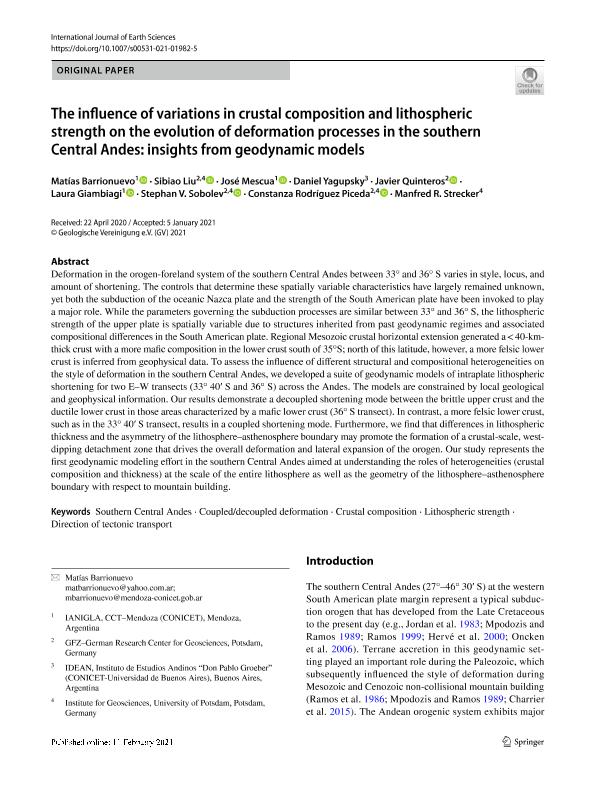Artículo
The influence of variations in crustal composition and lithospheric strength on the evolution of deformation processes in the southern Central Andes: insights from geodynamic models
Barrionuevo, Matías ; Liu, Sibiao; Mescua, Jose Francisco
; Liu, Sibiao; Mescua, Jose Francisco ; Yagupsky, Daniel Leonardo
; Yagupsky, Daniel Leonardo ; Quinteros, Javier; Giambiagi, Laura Beatriz
; Quinteros, Javier; Giambiagi, Laura Beatriz ; Sobolev, Stephan V.; Piceda, Constanza Rodríguez; Strecker, Manfred R.
; Sobolev, Stephan V.; Piceda, Constanza Rodríguez; Strecker, Manfred R.
 ; Liu, Sibiao; Mescua, Jose Francisco
; Liu, Sibiao; Mescua, Jose Francisco ; Yagupsky, Daniel Leonardo
; Yagupsky, Daniel Leonardo ; Quinteros, Javier; Giambiagi, Laura Beatriz
; Quinteros, Javier; Giambiagi, Laura Beatriz ; Sobolev, Stephan V.; Piceda, Constanza Rodríguez; Strecker, Manfred R.
; Sobolev, Stephan V.; Piceda, Constanza Rodríguez; Strecker, Manfred R.
Fecha de publicación:
02/2021
Editorial:
Springer
Revista:
International Journal of Earth Sciences
ISSN:
1437-3254
Idioma:
Inglés
Tipo de recurso:
Artículo publicado
Clasificación temática:
Resumen
Deformation in the orogen-foreland system of the southern Central Andes between 33° and 36° S varies in style, locus, and amount of shortening. The controls that determine these spatially variable characteristics have largely remained unknown, yet both the subduction of the oceanic Nazca plate and the strength of the South American plate have been invoked to play a major role. While the parameters governing the subduction processes are similar between 33° and 36° S, the lithospheric strength of the upper plate is spatially variable due to structures inherited from past geodynamic regimes and associated compositional differences in the South American plate. Regional Mesozoic crustal horizontal extension generated a < 40-km-thick crust with a more mafic composition in the lower crust south of 35°S; north of this latitude, however, a more felsic lower crust is inferred from geophysical data. To assess the influence of different structural and compositional heterogeneities on the style of deformation in the southern Central Andes, we developed a suite of geodynamic models of intraplate lithospheric shortening for two E–W transects (33° 40′ S and 36° S) across the Andes. The models are constrained by local geological and geophysical information. Our results demonstrate a decoupled shortening mode between the brittle upper crust and the ductile lower crust in those areas characterized by a mafic lower crust (36° S transect). In contrast, a more felsic lower crust, such as in the 33° 40′ S transect, results in a coupled shortening mode. Furthermore, we find that differences in lithospheric thickness and the asymmetry of the lithosphere–asthenosphere boundary may promote the formation of a crustal-scale, west-dipping detachment zone that drives the overall deformation and lateral expansion of the orogen. Our study represents the first geodynamic modeling effort in the southern Central Andes aimed at understanding the roles of heterogeneities (crustal composition and thickness) at the scale of the entire lithosphere as well as the geometry of the lithosphere–asthenosphere boundary with respect to mountain building.
Archivos asociados
Licencia
Identificadores
Colecciones
Articulos(IANIGLA)
Articulos de INST. ARG. DE NIVOLOGIA, GLACIOLOGIA Y CS. AMBIENT
Articulos de INST. ARG. DE NIVOLOGIA, GLACIOLOGIA Y CS. AMBIENT
Articulos(IDEAN)
Articulos de INSTITUTO DE ESTUDIOS ANDINOS "DON PABLO GROEBER"
Articulos de INSTITUTO DE ESTUDIOS ANDINOS "DON PABLO GROEBER"
Citación
Barrionuevo, Matías; Liu, Sibiao; Mescua, Jose Francisco; Yagupsky, Daniel Leonardo; Quinteros, Javier; et al.; The influence of variations in crustal composition and lithospheric strength on the evolution of deformation processes in the southern Central Andes: insights from geodynamic models; Springer; International Journal of Earth Sciences; 2-2021; 1-24
Compartir
Altmétricas



